Report on Communication Skills for Business - Unit 3.26
VerifiedAdded on 2022/12/26
|12
|3646
|1
Report
AI Summary
This report provides a comprehensive overview of communication skills in a business context. It begins by introducing communication models such as the Shannon and Weaver model and David Berlo's SMRC model, along with various communication systems like optical and radio systems. The report then details different communication methods used in organizations, including verbal, non-verbal, electronic, visual, and written communication, highlighting the benefits of both formal and informal communication. It explores the role of technology in facilitating different types of business communication, such as chat features, cloud technology, and emailing. Furthermore, the report outlines the principles of effective communication, including clarity, conciseness, and coherence, and identifies common barriers to effective communication, such as cultural differences and lack of transparency. The report also discusses oral communication styles and methods for different audiences, and the importance of responding to questions in a business presentation. Finally, the report provides examples of various communication writing formats including formal reports, letters, CVs, emails, webpages, and leaflets.
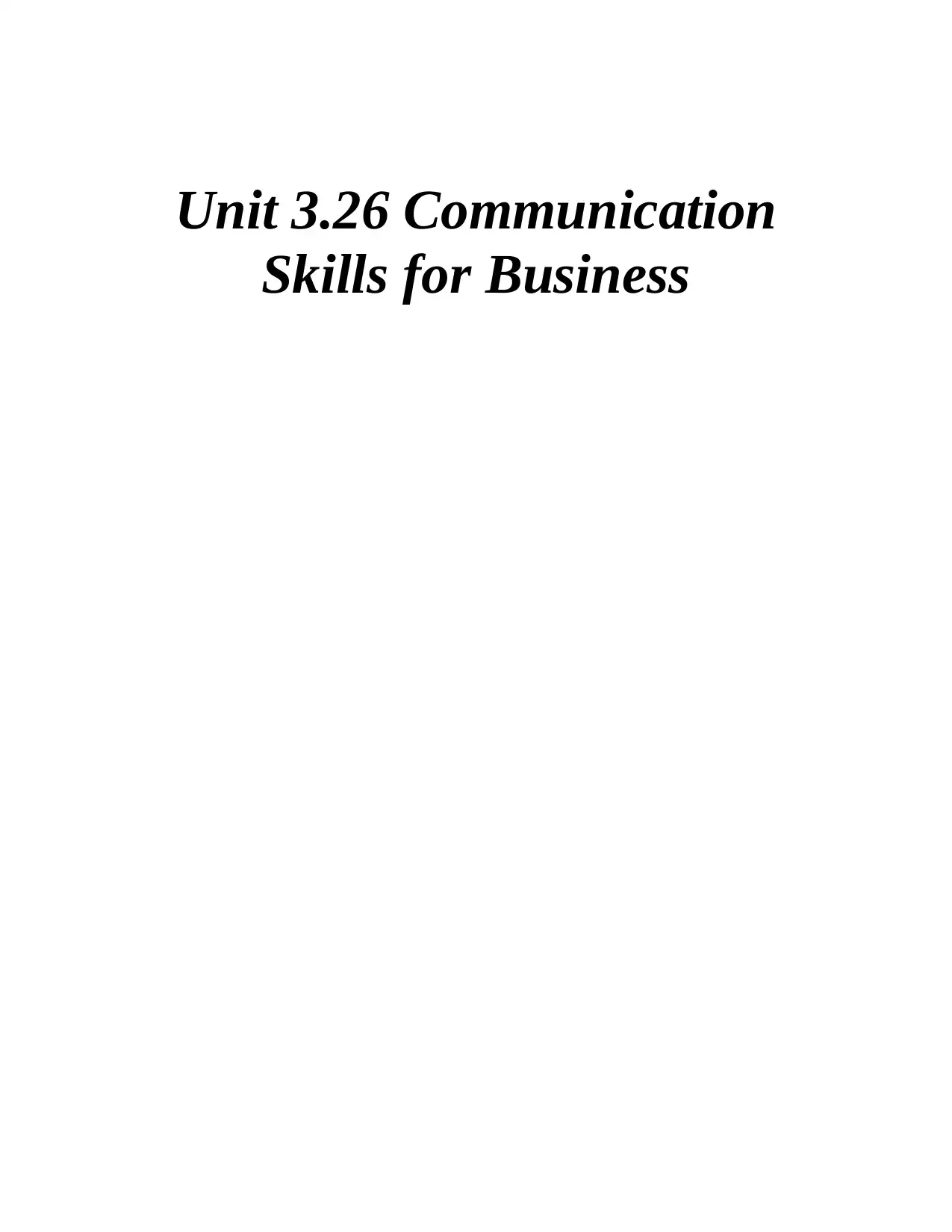
Unit 3.26 Communication
Skills for Business
Skills for Business
Paraphrase This Document
Need a fresh take? Get an instant paraphrase of this document with our AI Paraphraser
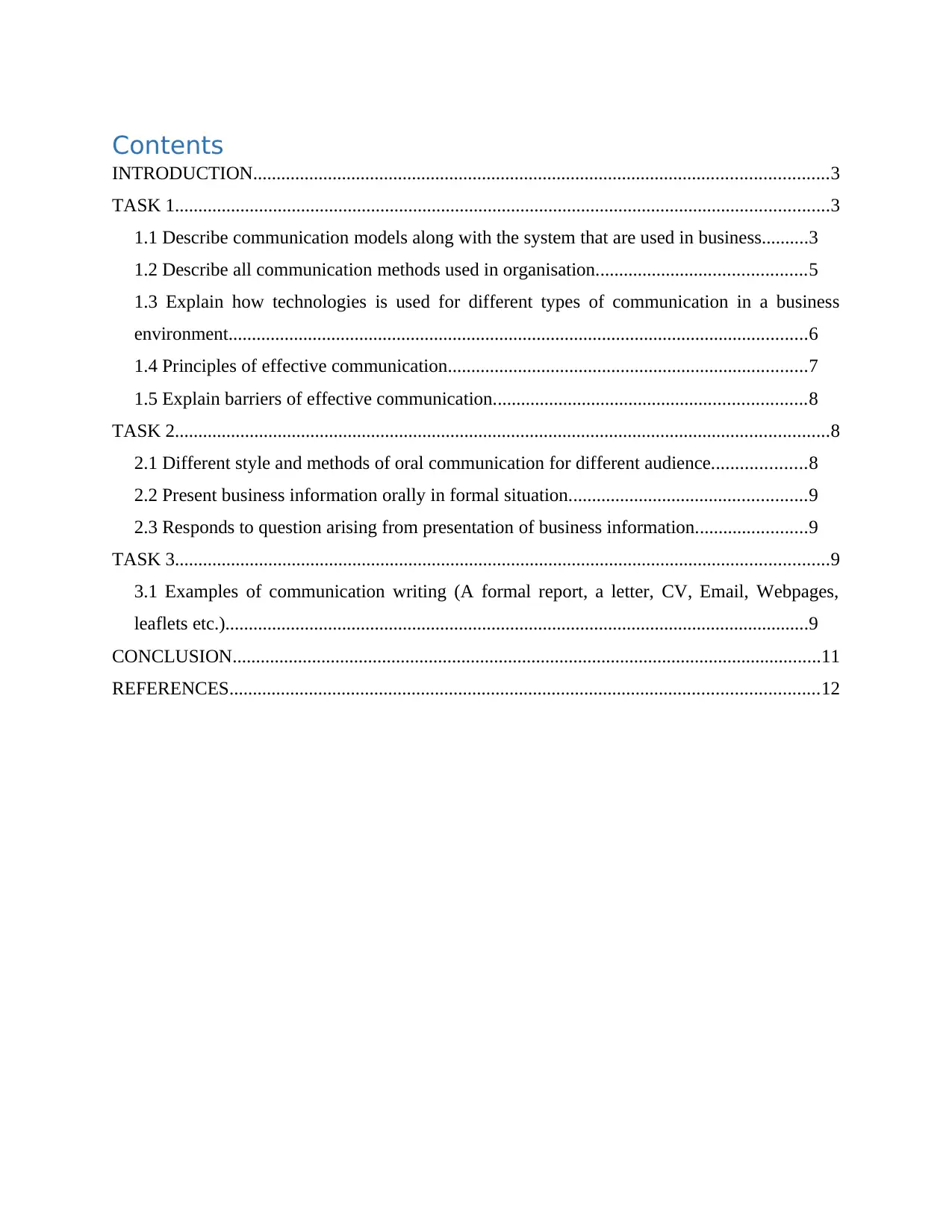
Contents
INTRODUCTION...........................................................................................................................3
TASK 1............................................................................................................................................3
1.1 Describe communication models along with the system that are used in business..........3
1.2 Describe all communication methods used in organisation.............................................5
1.3 Explain how technologies is used for different types of communication in a business
environment............................................................................................................................6
1.4 Principles of effective communication.............................................................................7
1.5 Explain barriers of effective communication...................................................................8
TASK 2............................................................................................................................................8
2.1 Different style and methods of oral communication for different audience....................8
2.2 Present business information orally in formal situation...................................................9
2.3 Responds to question arising from presentation of business information........................9
TASK 3............................................................................................................................................9
3.1 Examples of communication writing (A formal report, a letter, CV, Email, Webpages,
leaflets etc.).............................................................................................................................9
CONCLUSION..............................................................................................................................11
REFERENCES..............................................................................................................................12
INTRODUCTION...........................................................................................................................3
TASK 1............................................................................................................................................3
1.1 Describe communication models along with the system that are used in business..........3
1.2 Describe all communication methods used in organisation.............................................5
1.3 Explain how technologies is used for different types of communication in a business
environment............................................................................................................................6
1.4 Principles of effective communication.............................................................................7
1.5 Explain barriers of effective communication...................................................................8
TASK 2............................................................................................................................................8
2.1 Different style and methods of oral communication for different audience....................8
2.2 Present business information orally in formal situation...................................................9
2.3 Responds to question arising from presentation of business information........................9
TASK 3............................................................................................................................................9
3.1 Examples of communication writing (A formal report, a letter, CV, Email, Webpages,
leaflets etc.).............................................................................................................................9
CONCLUSION..............................................................................................................................11
REFERENCES..............................................................................................................................12
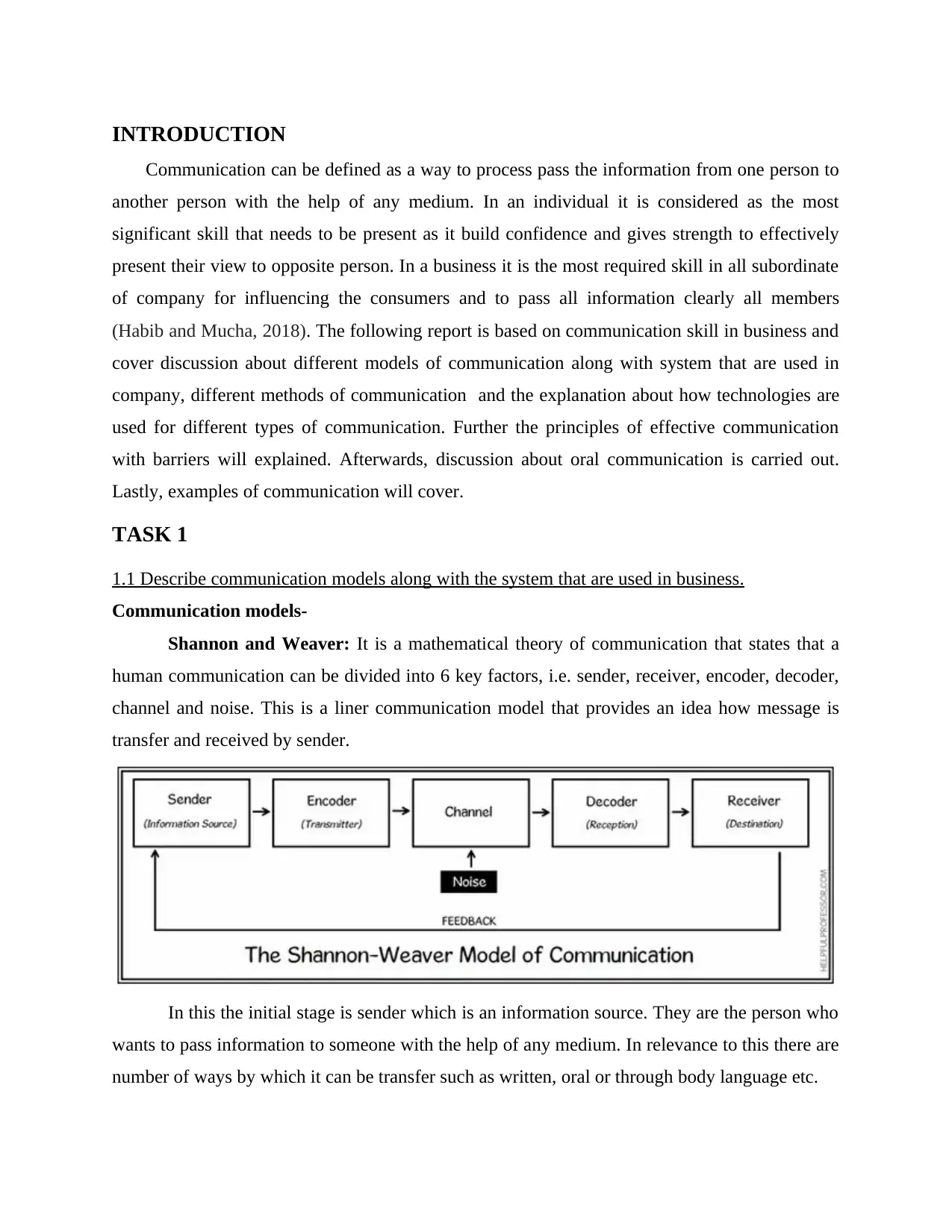
INTRODUCTION
Communication can be defined as a way to process pass the information from one person to
another person with the help of any medium. In an individual it is considered as the most
significant skill that needs to be present as it build confidence and gives strength to effectively
present their view to opposite person. In a business it is the most required skill in all subordinate
of company for influencing the consumers and to pass all information clearly all members
(Habib and Mucha, 2018). The following report is based on communication skill in business and
cover discussion about different models of communication along with system that are used in
company, different methods of communication and the explanation about how technologies are
used for different types of communication. Further the principles of effective communication
with barriers will explained. Afterwards, discussion about oral communication is carried out.
Lastly, examples of communication will cover.
TASK 1
1.1 Describe communication models along with the system that are used in business.
Communication models-
Shannon and Weaver: It is a mathematical theory of communication that states that a
human communication can be divided into 6 key factors, i.e. sender, receiver, encoder, decoder,
channel and noise. This is a liner communication model that provides an idea how message is
transfer and received by sender.
In this the initial stage is sender which is an information source. They are the person who
wants to pass information to someone with the help of any medium. In relevance to this there are
number of ways by which it can be transfer such as written, oral or through body language etc.
Communication can be defined as a way to process pass the information from one person to
another person with the help of any medium. In an individual it is considered as the most
significant skill that needs to be present as it build confidence and gives strength to effectively
present their view to opposite person. In a business it is the most required skill in all subordinate
of company for influencing the consumers and to pass all information clearly all members
(Habib and Mucha, 2018). The following report is based on communication skill in business and
cover discussion about different models of communication along with system that are used in
company, different methods of communication and the explanation about how technologies are
used for different types of communication. Further the principles of effective communication
with barriers will explained. Afterwards, discussion about oral communication is carried out.
Lastly, examples of communication will cover.
TASK 1
1.1 Describe communication models along with the system that are used in business.
Communication models-
Shannon and Weaver: It is a mathematical theory of communication that states that a
human communication can be divided into 6 key factors, i.e. sender, receiver, encoder, decoder,
channel and noise. This is a liner communication model that provides an idea how message is
transfer and received by sender.
In this the initial stage is sender which is an information source. They are the person who
wants to pass information to someone with the help of any medium. In relevance to this there are
number of ways by which it can be transfer such as written, oral or through body language etc.
⊘ This is a preview!⊘
Do you want full access?
Subscribe today to unlock all pages.

Trusted by 1+ million students worldwide
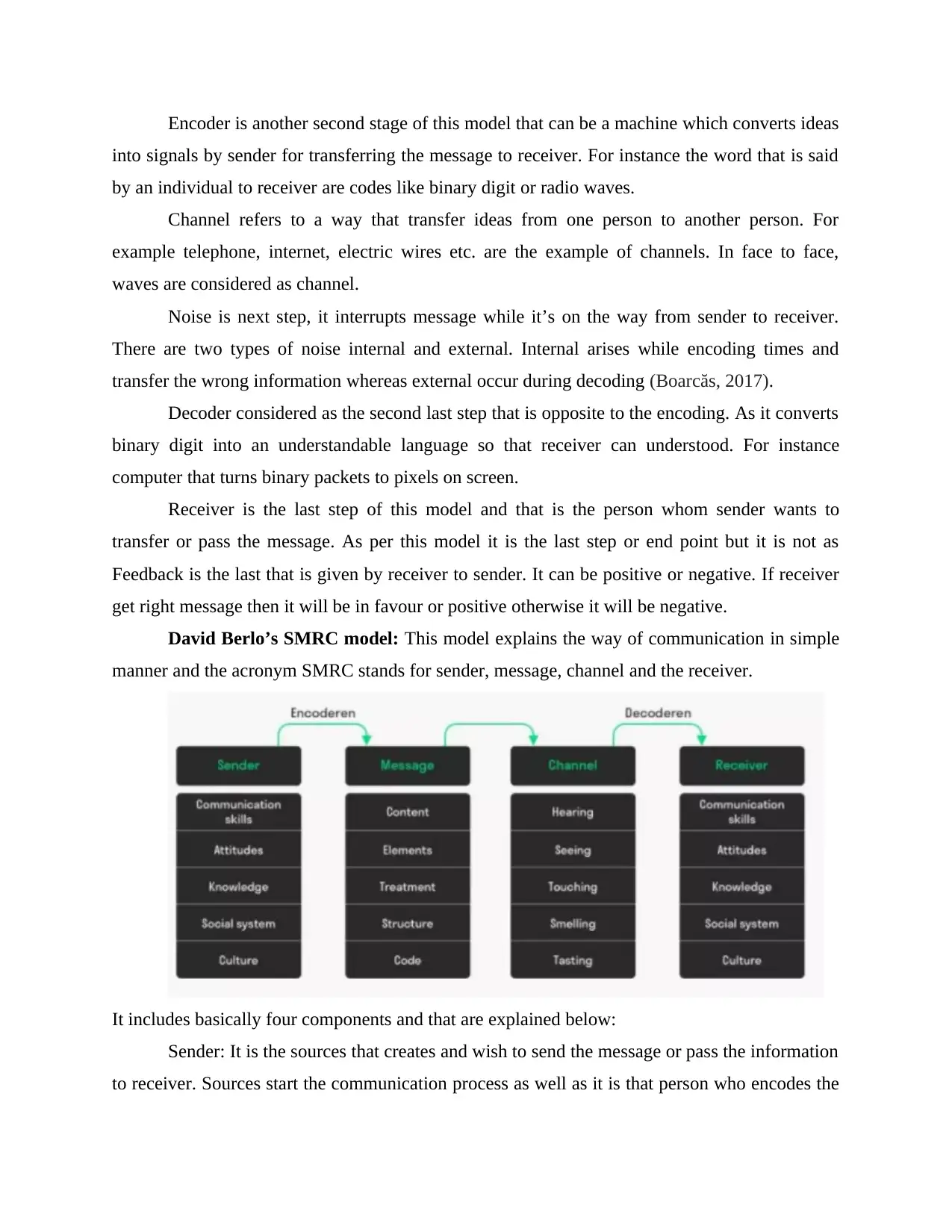
Encoder is another second stage of this model that can be a machine which converts ideas
into signals by sender for transferring the message to receiver. For instance the word that is said
by an individual to receiver are codes like binary digit or radio waves.
Channel refers to a way that transfer ideas from one person to another person. For
example telephone, internet, electric wires etc. are the example of channels. In face to face,
waves are considered as channel.
Noise is next step, it interrupts message while it’s on the way from sender to receiver.
There are two types of noise internal and external. Internal arises while encoding times and
transfer the wrong information whereas external occur during decoding (Boarcăs, 2017).
Decoder considered as the second last step that is opposite to the encoding. As it converts
binary digit into an understandable language so that receiver can understood. For instance
computer that turns binary packets to pixels on screen.
Receiver is the last step of this model and that is the person whom sender wants to
transfer or pass the message. As per this model it is the last step or end point but it is not as
Feedback is the last that is given by receiver to sender. It can be positive or negative. If receiver
get right message then it will be in favour or positive otherwise it will be negative.
David Berlo’s SMRC model: This model explains the way of communication in simple
manner and the acronym SMRC stands for sender, message, channel and the receiver.
It includes basically four components and that are explained below:
Sender: It is the sources that creates and wish to send the message or pass the information
to receiver. Sources start the communication process as well as it is that person who encodes the
into signals by sender for transferring the message to receiver. For instance the word that is said
by an individual to receiver are codes like binary digit or radio waves.
Channel refers to a way that transfer ideas from one person to another person. For
example telephone, internet, electric wires etc. are the example of channels. In face to face,
waves are considered as channel.
Noise is next step, it interrupts message while it’s on the way from sender to receiver.
There are two types of noise internal and external. Internal arises while encoding times and
transfer the wrong information whereas external occur during decoding (Boarcăs, 2017).
Decoder considered as the second last step that is opposite to the encoding. As it converts
binary digit into an understandable language so that receiver can understood. For instance
computer that turns binary packets to pixels on screen.
Receiver is the last step of this model and that is the person whom sender wants to
transfer or pass the message. As per this model it is the last step or end point but it is not as
Feedback is the last that is given by receiver to sender. It can be positive or negative. If receiver
get right message then it will be in favour or positive otherwise it will be negative.
David Berlo’s SMRC model: This model explains the way of communication in simple
manner and the acronym SMRC stands for sender, message, channel and the receiver.
It includes basically four components and that are explained below:
Sender: It is the sources that creates and wish to send the message or pass the information
to receiver. Sources start the communication process as well as it is that person who encodes the
Paraphrase This Document
Need a fresh take? Get an instant paraphrase of this document with our AI Paraphraser
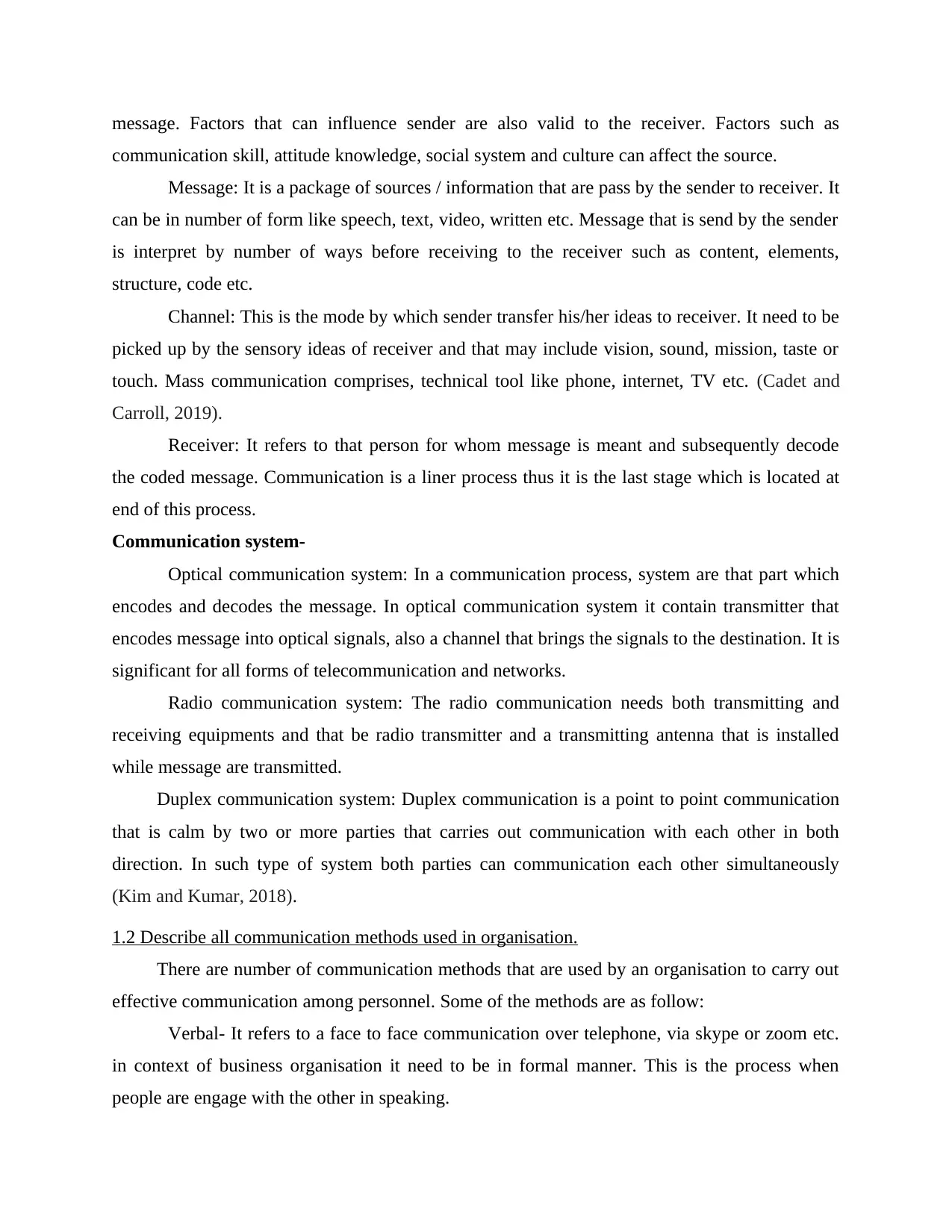
message. Factors that can influence sender are also valid to the receiver. Factors such as
communication skill, attitude knowledge, social system and culture can affect the source.
Message: It is a package of sources / information that are pass by the sender to receiver. It
can be in number of form like speech, text, video, written etc. Message that is send by the sender
is interpret by number of ways before receiving to the receiver such as content, elements,
structure, code etc.
Channel: This is the mode by which sender transfer his/her ideas to receiver. It need to be
picked up by the sensory ideas of receiver and that may include vision, sound, mission, taste or
touch. Mass communication comprises, technical tool like phone, internet, TV etc. (Cadet and
Carroll, 2019).
Receiver: It refers to that person for whom message is meant and subsequently decode
the coded message. Communication is a liner process thus it is the last stage which is located at
end of this process.
Communication system-
Optical communication system: In a communication process, system are that part which
encodes and decodes the message. In optical communication system it contain transmitter that
encodes message into optical signals, also a channel that brings the signals to the destination. It is
significant for all forms of telecommunication and networks.
Radio communication system: The radio communication needs both transmitting and
receiving equipments and that be radio transmitter and a transmitting antenna that is installed
while message are transmitted.
Duplex communication system: Duplex communication is a point to point communication
that is calm by two or more parties that carries out communication with each other in both
direction. In such type of system both parties can communication each other simultaneously
(Kim and Kumar, 2018).
1.2 Describe all communication methods used in organisation.
There are number of communication methods that are used by an organisation to carry out
effective communication among personnel. Some of the methods are as follow:
Verbal- It refers to a face to face communication over telephone, via skype or zoom etc.
in context of business organisation it need to be in formal manner. This is the process when
people are engage with the other in speaking.
communication skill, attitude knowledge, social system and culture can affect the source.
Message: It is a package of sources / information that are pass by the sender to receiver. It
can be in number of form like speech, text, video, written etc. Message that is send by the sender
is interpret by number of ways before receiving to the receiver such as content, elements,
structure, code etc.
Channel: This is the mode by which sender transfer his/her ideas to receiver. It need to be
picked up by the sensory ideas of receiver and that may include vision, sound, mission, taste or
touch. Mass communication comprises, technical tool like phone, internet, TV etc. (Cadet and
Carroll, 2019).
Receiver: It refers to that person for whom message is meant and subsequently decode
the coded message. Communication is a liner process thus it is the last stage which is located at
end of this process.
Communication system-
Optical communication system: In a communication process, system are that part which
encodes and decodes the message. In optical communication system it contain transmitter that
encodes message into optical signals, also a channel that brings the signals to the destination. It is
significant for all forms of telecommunication and networks.
Radio communication system: The radio communication needs both transmitting and
receiving equipments and that be radio transmitter and a transmitting antenna that is installed
while message are transmitted.
Duplex communication system: Duplex communication is a point to point communication
that is calm by two or more parties that carries out communication with each other in both
direction. In such type of system both parties can communication each other simultaneously
(Kim and Kumar, 2018).
1.2 Describe all communication methods used in organisation.
There are number of communication methods that are used by an organisation to carry out
effective communication among personnel. Some of the methods are as follow:
Verbal- It refers to a face to face communication over telephone, via skype or zoom etc.
in context of business organisation it need to be in formal manner. This is the process when
people are engage with the other in speaking.
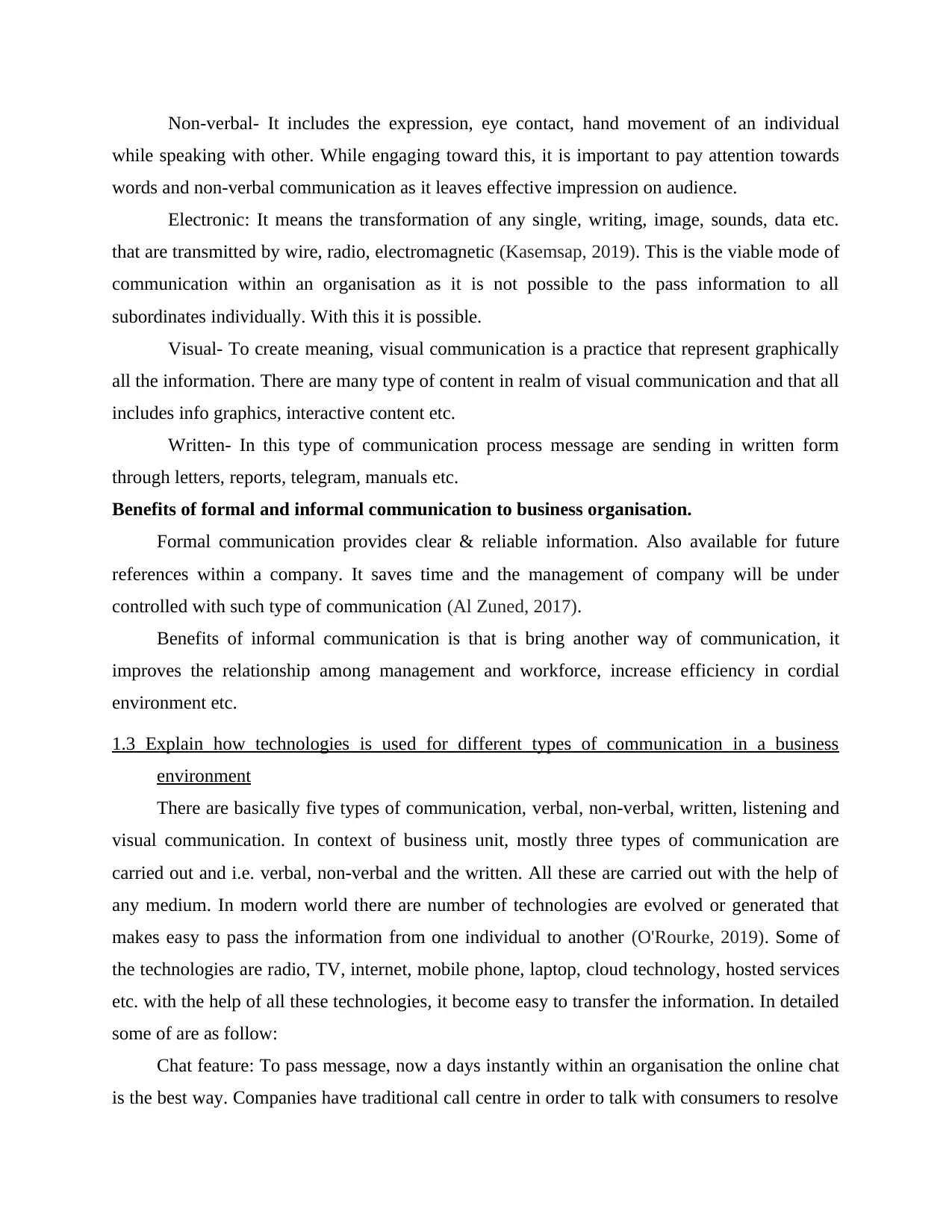
Non-verbal- It includes the expression, eye contact, hand movement of an individual
while speaking with other. While engaging toward this, it is important to pay attention towards
words and non-verbal communication as it leaves effective impression on audience.
Electronic: It means the transformation of any single, writing, image, sounds, data etc.
that are transmitted by wire, radio, electromagnetic (Kasemsap, 2019). This is the viable mode of
communication within an organisation as it is not possible to the pass information to all
subordinates individually. With this it is possible.
Visual- To create meaning, visual communication is a practice that represent graphically
all the information. There are many type of content in realm of visual communication and that all
includes info graphics, interactive content etc.
Written- In this type of communication process message are sending in written form
through letters, reports, telegram, manuals etc.
Benefits of formal and informal communication to business organisation.
Formal communication provides clear & reliable information. Also available for future
references within a company. It saves time and the management of company will be under
controlled with such type of communication (Al Zuned, 2017).
Benefits of informal communication is that is bring another way of communication, it
improves the relationship among management and workforce, increase efficiency in cordial
environment etc.
1.3 Explain how technologies is used for different types of communication in a business
environment
There are basically five types of communication, verbal, non-verbal, written, listening and
visual communication. In context of business unit, mostly three types of communication are
carried out and i.e. verbal, non-verbal and the written. All these are carried out with the help of
any medium. In modern world there are number of technologies are evolved or generated that
makes easy to pass the information from one individual to another (O'Rourke, 2019). Some of
the technologies are radio, TV, internet, mobile phone, laptop, cloud technology, hosted services
etc. with the help of all these technologies, it become easy to transfer the information. In detailed
some of are as follow:
Chat feature: To pass message, now a days instantly within an organisation the online chat
is the best way. Companies have traditional call centre in order to talk with consumers to resolve
while speaking with other. While engaging toward this, it is important to pay attention towards
words and non-verbal communication as it leaves effective impression on audience.
Electronic: It means the transformation of any single, writing, image, sounds, data etc.
that are transmitted by wire, radio, electromagnetic (Kasemsap, 2019). This is the viable mode of
communication within an organisation as it is not possible to the pass information to all
subordinates individually. With this it is possible.
Visual- To create meaning, visual communication is a practice that represent graphically
all the information. There are many type of content in realm of visual communication and that all
includes info graphics, interactive content etc.
Written- In this type of communication process message are sending in written form
through letters, reports, telegram, manuals etc.
Benefits of formal and informal communication to business organisation.
Formal communication provides clear & reliable information. Also available for future
references within a company. It saves time and the management of company will be under
controlled with such type of communication (Al Zuned, 2017).
Benefits of informal communication is that is bring another way of communication, it
improves the relationship among management and workforce, increase efficiency in cordial
environment etc.
1.3 Explain how technologies is used for different types of communication in a business
environment
There are basically five types of communication, verbal, non-verbal, written, listening and
visual communication. In context of business unit, mostly three types of communication are
carried out and i.e. verbal, non-verbal and the written. All these are carried out with the help of
any medium. In modern world there are number of technologies are evolved or generated that
makes easy to pass the information from one individual to another (O'Rourke, 2019). Some of
the technologies are radio, TV, internet, mobile phone, laptop, cloud technology, hosted services
etc. with the help of all these technologies, it become easy to transfer the information. In detailed
some of are as follow:
Chat feature: To pass message, now a days instantly within an organisation the online chat
is the best way. Companies have traditional call centre in order to talk with consumers to resolve
⊘ This is a preview!⊘
Do you want full access?
Subscribe today to unlock all pages.

Trusted by 1+ million students worldwide
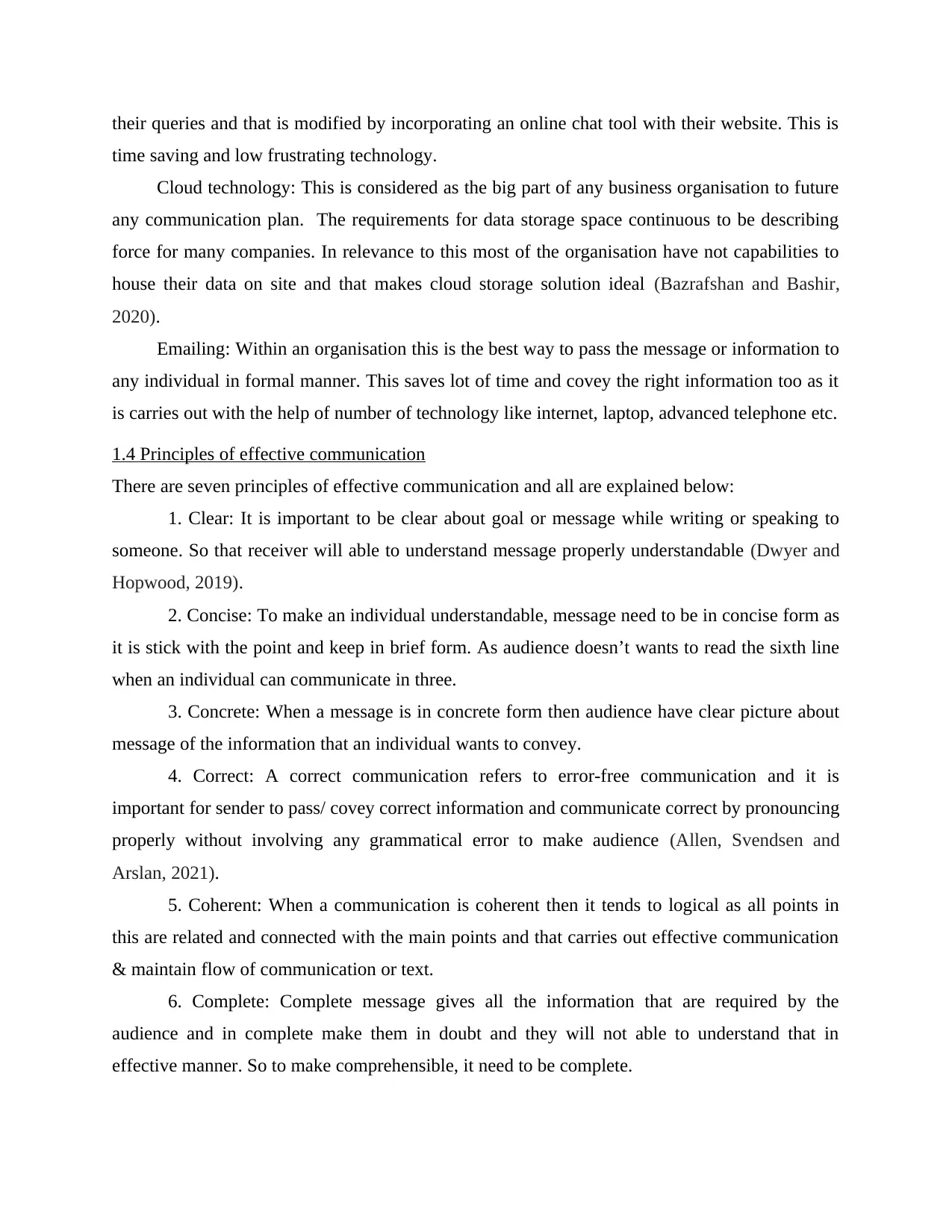
their queries and that is modified by incorporating an online chat tool with their website. This is
time saving and low frustrating technology.
Cloud technology: This is considered as the big part of any business organisation to future
any communication plan. The requirements for data storage space continuous to be describing
force for many companies. In relevance to this most of the organisation have not capabilities to
house their data on site and that makes cloud storage solution ideal (Bazrafshan and Bashir,
2020).
Emailing: Within an organisation this is the best way to pass the message or information to
any individual in formal manner. This saves lot of time and covey the right information too as it
is carries out with the help of number of technology like internet, laptop, advanced telephone etc.
1.4 Principles of effective communication
There are seven principles of effective communication and all are explained below:
1. Clear: It is important to be clear about goal or message while writing or speaking to
someone. So that receiver will able to understand message properly understandable (Dwyer and
Hopwood, 2019).
2. Concise: To make an individual understandable, message need to be in concise form as
it is stick with the point and keep in brief form. As audience doesn’t wants to read the sixth line
when an individual can communicate in three.
3. Concrete: When a message is in concrete form then audience have clear picture about
message of the information that an individual wants to convey.
4. Correct: A correct communication refers to error-free communication and it is
important for sender to pass/ covey correct information and communicate correct by pronouncing
properly without involving any grammatical error to make audience (Allen, Svendsen and
Arslan, 2021).
5. Coherent: When a communication is coherent then it tends to logical as all points in
this are related and connected with the main points and that carries out effective communication
& maintain flow of communication or text.
6. Complete: Complete message gives all the information that are required by the
audience and in complete make them in doubt and they will not able to understand that in
effective manner. So to make comprehensible, it need to be complete.
time saving and low frustrating technology.
Cloud technology: This is considered as the big part of any business organisation to future
any communication plan. The requirements for data storage space continuous to be describing
force for many companies. In relevance to this most of the organisation have not capabilities to
house their data on site and that makes cloud storage solution ideal (Bazrafshan and Bashir,
2020).
Emailing: Within an organisation this is the best way to pass the message or information to
any individual in formal manner. This saves lot of time and covey the right information too as it
is carries out with the help of number of technology like internet, laptop, advanced telephone etc.
1.4 Principles of effective communication
There are seven principles of effective communication and all are explained below:
1. Clear: It is important to be clear about goal or message while writing or speaking to
someone. So that receiver will able to understand message properly understandable (Dwyer and
Hopwood, 2019).
2. Concise: To make an individual understandable, message need to be in concise form as
it is stick with the point and keep in brief form. As audience doesn’t wants to read the sixth line
when an individual can communicate in three.
3. Concrete: When a message is in concrete form then audience have clear picture about
message of the information that an individual wants to convey.
4. Correct: A correct communication refers to error-free communication and it is
important for sender to pass/ covey correct information and communicate correct by pronouncing
properly without involving any grammatical error to make audience (Allen, Svendsen and
Arslan, 2021).
5. Coherent: When a communication is coherent then it tends to logical as all points in
this are related and connected with the main points and that carries out effective communication
& maintain flow of communication or text.
6. Complete: Complete message gives all the information that are required by the
audience and in complete make them in doubt and they will not able to understand that in
effective manner. So to make comprehensible, it need to be complete.
Paraphrase This Document
Need a fresh take? Get an instant paraphrase of this document with our AI Paraphraser
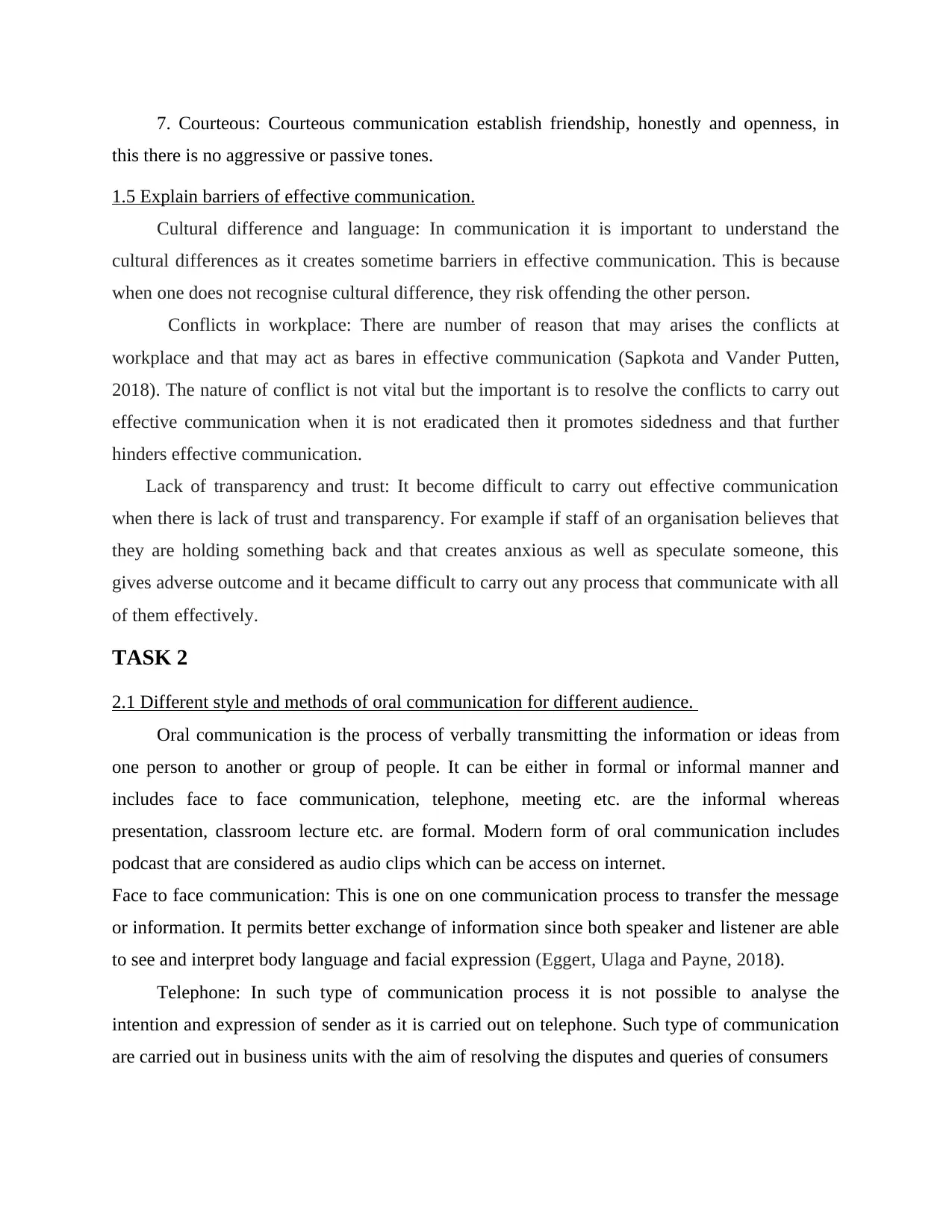
7. Courteous: Courteous communication establish friendship, honestly and openness, in
this there is no aggressive or passive tones.
1.5 Explain barriers of effective communication.
Cultural difference and language: In communication it is important to understand the
cultural differences as it creates sometime barriers in effective communication. This is because
when one does not recognise cultural difference, they risk offending the other person.
Conflicts in workplace: There are number of reason that may arises the conflicts at
workplace and that may act as bares in effective communication (Sapkota and Vander Putten,
2018). The nature of conflict is not vital but the important is to resolve the conflicts to carry out
effective communication when it is not eradicated then it promotes sidedness and that further
hinders effective communication.
Lack of transparency and trust: It become difficult to carry out effective communication
when there is lack of trust and transparency. For example if staff of an organisation believes that
they are holding something back and that creates anxious as well as speculate someone, this
gives adverse outcome and it became difficult to carry out any process that communicate with all
of them effectively.
TASK 2
2.1 Different style and methods of oral communication for different audience.
Oral communication is the process of verbally transmitting the information or ideas from
one person to another or group of people. It can be either in formal or informal manner and
includes face to face communication, telephone, meeting etc. are the informal whereas
presentation, classroom lecture etc. are formal. Modern form of oral communication includes
podcast that are considered as audio clips which can be access on internet.
Face to face communication: This is one on one communication process to transfer the message
or information. It permits better exchange of information since both speaker and listener are able
to see and interpret body language and facial expression (Eggert, Ulaga and Payne, 2018).
Telephone: In such type of communication process it is not possible to analyse the
intention and expression of sender as it is carried out on telephone. Such type of communication
are carried out in business units with the aim of resolving the disputes and queries of consumers
this there is no aggressive or passive tones.
1.5 Explain barriers of effective communication.
Cultural difference and language: In communication it is important to understand the
cultural differences as it creates sometime barriers in effective communication. This is because
when one does not recognise cultural difference, they risk offending the other person.
Conflicts in workplace: There are number of reason that may arises the conflicts at
workplace and that may act as bares in effective communication (Sapkota and Vander Putten,
2018). The nature of conflict is not vital but the important is to resolve the conflicts to carry out
effective communication when it is not eradicated then it promotes sidedness and that further
hinders effective communication.
Lack of transparency and trust: It become difficult to carry out effective communication
when there is lack of trust and transparency. For example if staff of an organisation believes that
they are holding something back and that creates anxious as well as speculate someone, this
gives adverse outcome and it became difficult to carry out any process that communicate with all
of them effectively.
TASK 2
2.1 Different style and methods of oral communication for different audience.
Oral communication is the process of verbally transmitting the information or ideas from
one person to another or group of people. It can be either in formal or informal manner and
includes face to face communication, telephone, meeting etc. are the informal whereas
presentation, classroom lecture etc. are formal. Modern form of oral communication includes
podcast that are considered as audio clips which can be access on internet.
Face to face communication: This is one on one communication process to transfer the message
or information. It permits better exchange of information since both speaker and listener are able
to see and interpret body language and facial expression (Eggert, Ulaga and Payne, 2018).
Telephone: In such type of communication process it is not possible to analyse the
intention and expression of sender as it is carried out on telephone. Such type of communication
are carried out in business units with the aim of resolving the disputes and queries of consumers
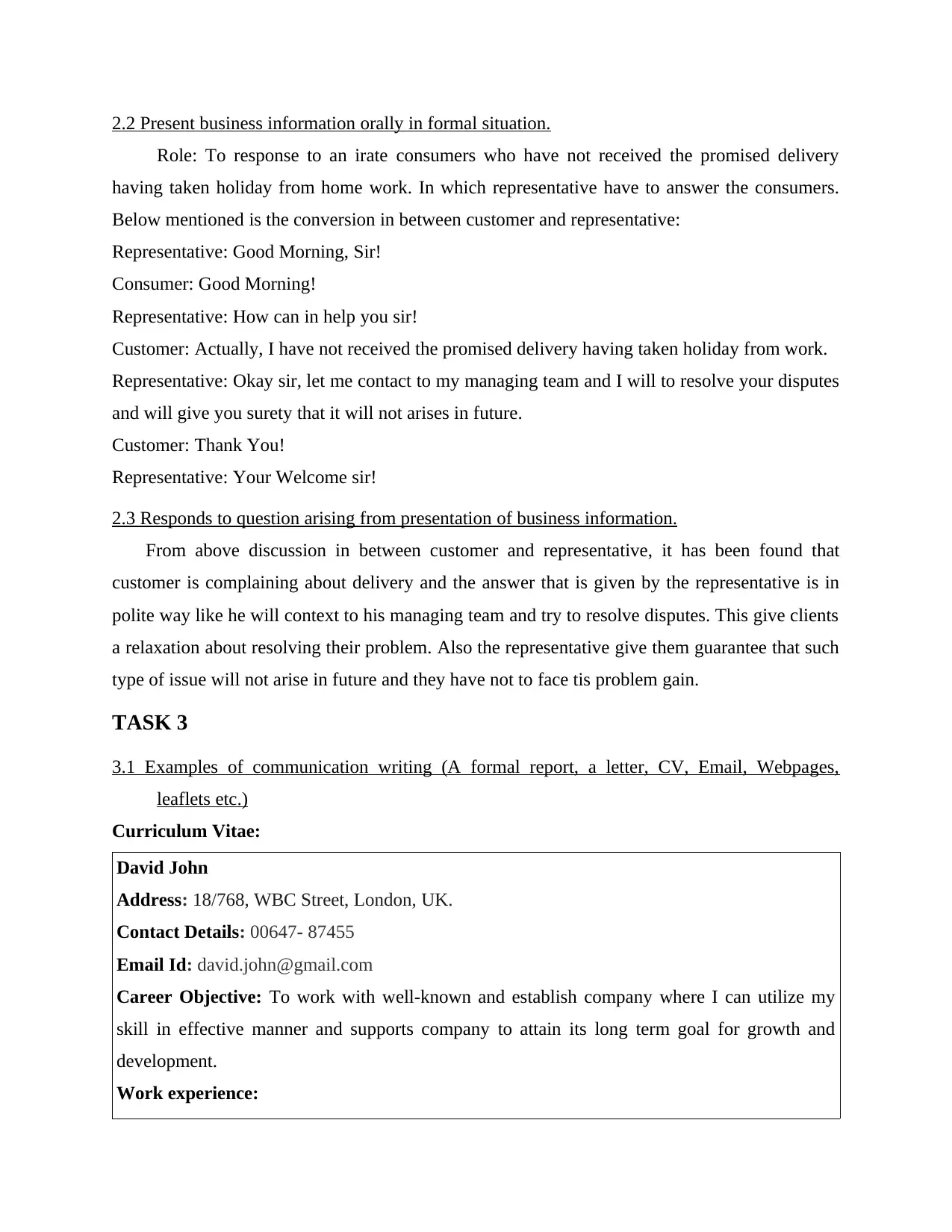
2.2 Present business information orally in formal situation.
Role: To response to an irate consumers who have not received the promised delivery
having taken holiday from home work. In which representative have to answer the consumers.
Below mentioned is the conversion in between customer and representative:
Representative: Good Morning, Sir!
Consumer: Good Morning!
Representative: How can in help you sir!
Customer: Actually, I have not received the promised delivery having taken holiday from work.
Representative: Okay sir, let me contact to my managing team and I will to resolve your disputes
and will give you surety that it will not arises in future.
Customer: Thank You!
Representative: Your Welcome sir!
2.3 Responds to question arising from presentation of business information.
From above discussion in between customer and representative, it has been found that
customer is complaining about delivery and the answer that is given by the representative is in
polite way like he will context to his managing team and try to resolve disputes. This give clients
a relaxation about resolving their problem. Also the representative give them guarantee that such
type of issue will not arise in future and they have not to face tis problem gain.
TASK 3
3.1 Examples of communication writing (A formal report, a letter, CV, Email, Webpages,
leaflets etc.)
Curriculum Vitae:
David John
Address: 18/768, WBC Street, London, UK.
Contact Details: 00647- 87455
Email Id: david.john@gmail.com
Career Objective: To work with well-known and establish company where I can utilize my
skill in effective manner and supports company to attain its long term goal for growth and
development.
Work experience:
Role: To response to an irate consumers who have not received the promised delivery
having taken holiday from home work. In which representative have to answer the consumers.
Below mentioned is the conversion in between customer and representative:
Representative: Good Morning, Sir!
Consumer: Good Morning!
Representative: How can in help you sir!
Customer: Actually, I have not received the promised delivery having taken holiday from work.
Representative: Okay sir, let me contact to my managing team and I will to resolve your disputes
and will give you surety that it will not arises in future.
Customer: Thank You!
Representative: Your Welcome sir!
2.3 Responds to question arising from presentation of business information.
From above discussion in between customer and representative, it has been found that
customer is complaining about delivery and the answer that is given by the representative is in
polite way like he will context to his managing team and try to resolve disputes. This give clients
a relaxation about resolving their problem. Also the representative give them guarantee that such
type of issue will not arise in future and they have not to face tis problem gain.
TASK 3
3.1 Examples of communication writing (A formal report, a letter, CV, Email, Webpages,
leaflets etc.)
Curriculum Vitae:
David John
Address: 18/768, WBC Street, London, UK.
Contact Details: 00647- 87455
Email Id: david.john@gmail.com
Career Objective: To work with well-known and establish company where I can utilize my
skill in effective manner and supports company to attain its long term goal for growth and
development.
Work experience:
⊘ This is a preview!⊘
Do you want full access?
Subscribe today to unlock all pages.

Trusted by 1+ million students worldwide
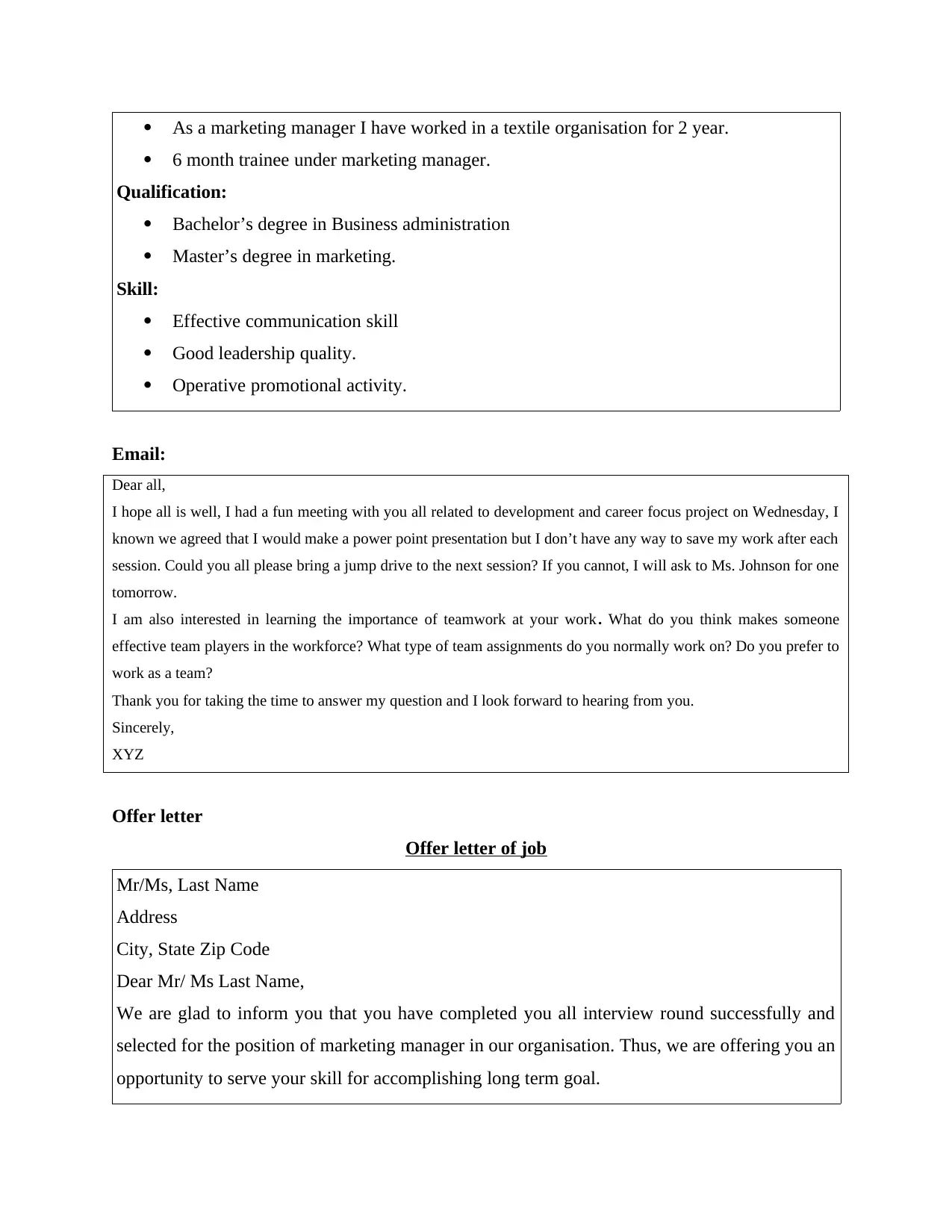
As a marketing manager I have worked in a textile organisation for 2 year.
6 month trainee under marketing manager.
Qualification:
Bachelor’s degree in Business administration
Master’s degree in marketing.
Skill:
Effective communication skill
Good leadership quality.
Operative promotional activity.
Email:
Dear all,
I hope all is well, I had a fun meeting with you all related to development and career focus project on Wednesday, I
known we agreed that I would make a power point presentation but I don’t have any way to save my work after each
session. Could you all please bring a jump drive to the next session? If you cannot, I will ask to Ms. Johnson for one
tomorrow.
I am also interested in learning the importance of teamwork at your work. What do you think makes someone
effective team players in the workforce? What type of team assignments do you normally work on? Do you prefer to
work as a team?
Thank you for taking the time to answer my question and I look forward to hearing from you.
Sincerely,
XYZ
Offer letter
Offer letter of job
Mr/Ms, Last Name
Address
City, State Zip Code
Dear Mr/ Ms Last Name,
We are glad to inform you that you have completed you all interview round successfully and
selected for the position of marketing manager in our organisation. Thus, we are offering you an
opportunity to serve your skill for accomplishing long term goal.
6 month trainee under marketing manager.
Qualification:
Bachelor’s degree in Business administration
Master’s degree in marketing.
Skill:
Effective communication skill
Good leadership quality.
Operative promotional activity.
Email:
Dear all,
I hope all is well, I had a fun meeting with you all related to development and career focus project on Wednesday, I
known we agreed that I would make a power point presentation but I don’t have any way to save my work after each
session. Could you all please bring a jump drive to the next session? If you cannot, I will ask to Ms. Johnson for one
tomorrow.
I am also interested in learning the importance of teamwork at your work. What do you think makes someone
effective team players in the workforce? What type of team assignments do you normally work on? Do you prefer to
work as a team?
Thank you for taking the time to answer my question and I look forward to hearing from you.
Sincerely,
XYZ
Offer letter
Offer letter of job
Mr/Ms, Last Name
Address
City, State Zip Code
Dear Mr/ Ms Last Name,
We are glad to inform you that you have completed you all interview round successfully and
selected for the position of marketing manager in our organisation. Thus, we are offering you an
opportunity to serve your skill for accomplishing long term goal.
Paraphrase This Document
Need a fresh take? Get an instant paraphrase of this document with our AI Paraphraser
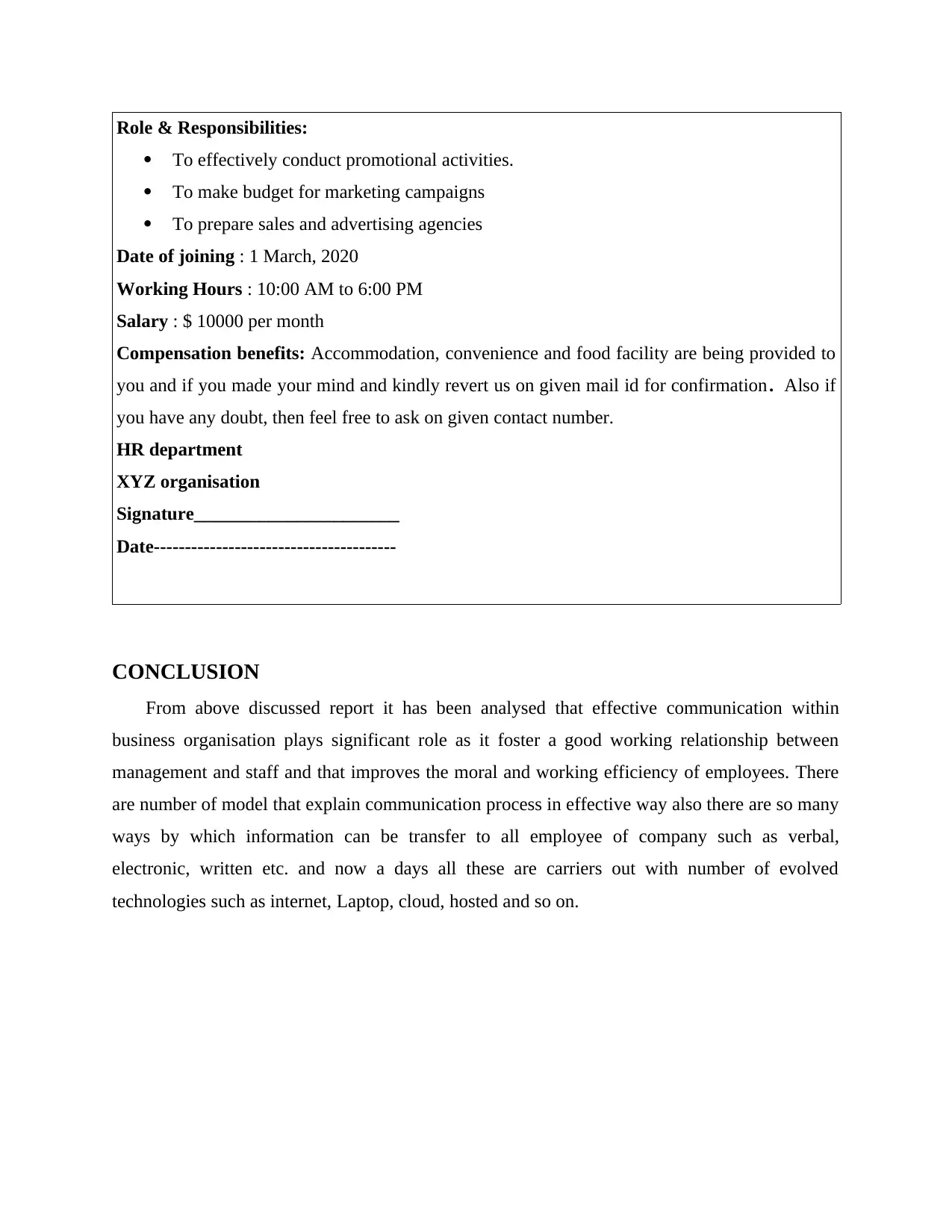
Role & Responsibilities:
To effectively conduct promotional activities.
To make budget for marketing campaigns
To prepare sales and advertising agencies
Date of joining : 1 March, 2020
Working Hours : 10:00 AM to 6:00 PM
Salary : $ 10000 per month
Compensation benefits: Accommodation, convenience and food facility are being provided to
you and if you made your mind and kindly revert us on given mail id for confirmation. Also if
you have any doubt, then feel free to ask on given contact number.
HR department
XYZ organisation
Signature______________________
Date---------------------------------------
CONCLUSION
From above discussed report it has been analysed that effective communication within
business organisation plays significant role as it foster a good working relationship between
management and staff and that improves the moral and working efficiency of employees. There
are number of model that explain communication process in effective way also there are so many
ways by which information can be transfer to all employee of company such as verbal,
electronic, written etc. and now a days all these are carriers out with number of evolved
technologies such as internet, Laptop, cloud, hosted and so on.
To effectively conduct promotional activities.
To make budget for marketing campaigns
To prepare sales and advertising agencies
Date of joining : 1 March, 2020
Working Hours : 10:00 AM to 6:00 PM
Salary : $ 10000 per month
Compensation benefits: Accommodation, convenience and food facility are being provided to
you and if you made your mind and kindly revert us on given mail id for confirmation. Also if
you have any doubt, then feel free to ask on given contact number.
HR department
XYZ organisation
Signature______________________
Date---------------------------------------
CONCLUSION
From above discussed report it has been analysed that effective communication within
business organisation plays significant role as it foster a good working relationship between
management and staff and that improves the moral and working efficiency of employees. There
are number of model that explain communication process in effective way also there are so many
ways by which information can be transfer to all employee of company such as verbal,
electronic, written etc. and now a days all these are carriers out with number of evolved
technologies such as internet, Laptop, cloud, hosted and so on.
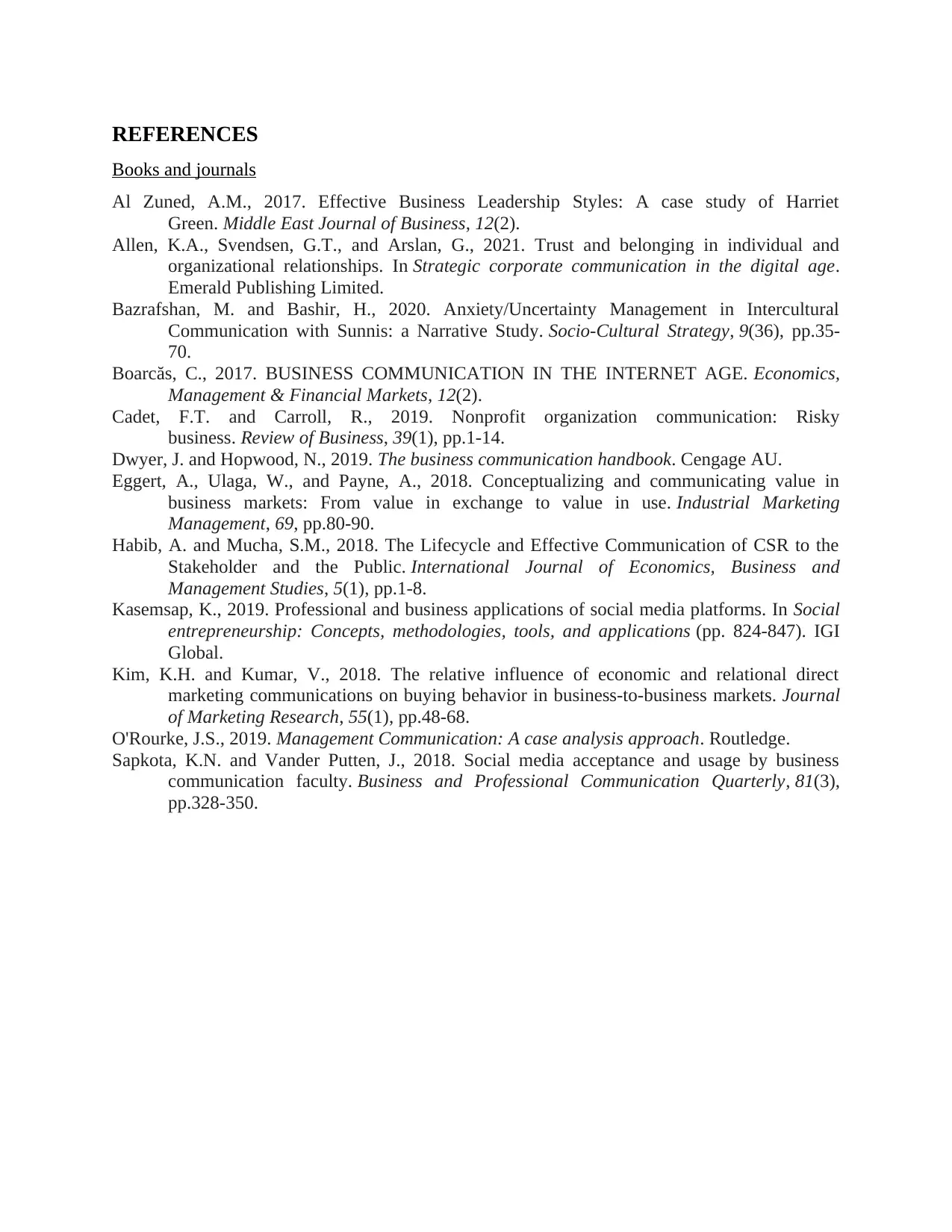
REFERENCES
Books and journals
Al Zuned, A.M., 2017. Effective Business Leadership Styles: A case study of Harriet
Green. Middle East Journal of Business, 12(2).
Allen, K.A., Svendsen, G.T., and Arslan, G., 2021. Trust and belonging in individual and
organizational relationships. In Strategic corporate communication in the digital age.
Emerald Publishing Limited.
Bazrafshan, M. and Bashir, H., 2020. Anxiety/Uncertainty Management in Intercultural
Communication with Sunnis: a Narrative Study. Socio-Cultural Strategy, 9(36), pp.35-
70.
Boarcăs, C., 2017. BUSINESS COMMUNICATION IN THE INTERNET AGE. Economics,
Management & Financial Markets, 12(2).
Cadet, F.T. and Carroll, R., 2019. Nonprofit organization communication: Risky
business. Review of Business, 39(1), pp.1-14.
Dwyer, J. and Hopwood, N., 2019. The business communication handbook. Cengage AU.
Eggert, A., Ulaga, W., and Payne, A., 2018. Conceptualizing and communicating value in
business markets: From value in exchange to value in use. Industrial Marketing
Management, 69, pp.80-90.
Habib, A. and Mucha, S.M., 2018. The Lifecycle and Effective Communication of CSR to the
Stakeholder and the Public. International Journal of Economics, Business and
Management Studies, 5(1), pp.1-8.
Kasemsap, K., 2019. Professional and business applications of social media platforms. In Social
entrepreneurship: Concepts, methodologies, tools, and applications (pp. 824-847). IGI
Global.
Kim, K.H. and Kumar, V., 2018. The relative influence of economic and relational direct
marketing communications on buying behavior in business-to-business markets. Journal
of Marketing Research, 55(1), pp.48-68.
O'Rourke, J.S., 2019. Management Communication: A case analysis approach. Routledge.
Sapkota, K.N. and Vander Putten, J., 2018. Social media acceptance and usage by business
communication faculty. Business and Professional Communication Quarterly, 81(3),
pp.328-350.
Books and journals
Al Zuned, A.M., 2017. Effective Business Leadership Styles: A case study of Harriet
Green. Middle East Journal of Business, 12(2).
Allen, K.A., Svendsen, G.T., and Arslan, G., 2021. Trust and belonging in individual and
organizational relationships. In Strategic corporate communication in the digital age.
Emerald Publishing Limited.
Bazrafshan, M. and Bashir, H., 2020. Anxiety/Uncertainty Management in Intercultural
Communication with Sunnis: a Narrative Study. Socio-Cultural Strategy, 9(36), pp.35-
70.
Boarcăs, C., 2017. BUSINESS COMMUNICATION IN THE INTERNET AGE. Economics,
Management & Financial Markets, 12(2).
Cadet, F.T. and Carroll, R., 2019. Nonprofit organization communication: Risky
business. Review of Business, 39(1), pp.1-14.
Dwyer, J. and Hopwood, N., 2019. The business communication handbook. Cengage AU.
Eggert, A., Ulaga, W., and Payne, A., 2018. Conceptualizing and communicating value in
business markets: From value in exchange to value in use. Industrial Marketing
Management, 69, pp.80-90.
Habib, A. and Mucha, S.M., 2018. The Lifecycle and Effective Communication of CSR to the
Stakeholder and the Public. International Journal of Economics, Business and
Management Studies, 5(1), pp.1-8.
Kasemsap, K., 2019. Professional and business applications of social media platforms. In Social
entrepreneurship: Concepts, methodologies, tools, and applications (pp. 824-847). IGI
Global.
Kim, K.H. and Kumar, V., 2018. The relative influence of economic and relational direct
marketing communications on buying behavior in business-to-business markets. Journal
of Marketing Research, 55(1), pp.48-68.
O'Rourke, J.S., 2019. Management Communication: A case analysis approach. Routledge.
Sapkota, K.N. and Vander Putten, J., 2018. Social media acceptance and usage by business
communication faculty. Business and Professional Communication Quarterly, 81(3),
pp.328-350.
⊘ This is a preview!⊘
Do you want full access?
Subscribe today to unlock all pages.

Trusted by 1+ million students worldwide
1 out of 12
Related Documents
Your All-in-One AI-Powered Toolkit for Academic Success.
+13062052269
info@desklib.com
Available 24*7 on WhatsApp / Email
![[object Object]](/_next/static/media/star-bottom.7253800d.svg)
Unlock your academic potential
Copyright © 2020–2025 A2Z Services. All Rights Reserved. Developed and managed by ZUCOL.



